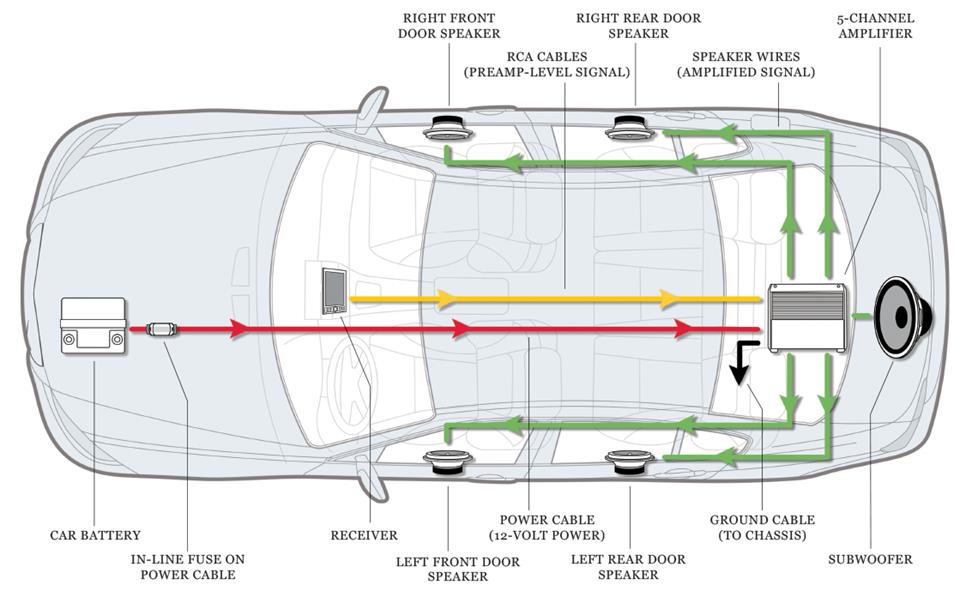Crank Up Your Ride: The Ultimate Guide to Adding an Amp to Your Factory Stereo
Is your car's audio system leaving you wanting more? You love your car, but the factory stereo just isn't cutting it. You crave deeper bass, crisper highs, and a sound that truly moves you. Adding an amplifier to your factory stereo might be the perfect solution. It's a popular upgrade that can dramatically improve your in-car listening experience without requiring a complete system overhaul.
Integrating an amplifier with your factory head unit can seem daunting, but with the right information and a bit of patience, it's a manageable DIY project for most car enthusiasts. This guide will walk you through the process, from understanding the basics to troubleshooting common issues. Prepare to transform your daily commute into a concert on wheels.
Before diving into the how-to, let's take a quick look at why amplifying your existing stereo is a game-changer. Factory car stereos are often designed to be cost-effective, not audiophile-grade. They typically use lower-powered amplifiers and less-than-ideal speakers, resulting in a sound that lacks depth and clarity. An aftermarket amplifier injects much-needed power, allowing your speakers to perform at their full potential and deliver a richer, more immersive sound.
The evolution of car audio has seen significant improvements in amplifier technology, making them smaller, more efficient, and more affordable. Early car amplifiers were bulky and power-hungry, but today's models offer impressive performance in compact packages. This makes adding an amplifier to a factory system a much simpler and more accessible upgrade.
One of the primary challenges in adding an amplifier to a factory stereo is dealing with the head unit's limited output options. Unlike aftermarket head units, factory stereos often lack dedicated RCA pre-amp outputs, which are typically used to connect to an amplifier. This necessitates the use of a line output converter, a device that converts the speaker-level signals from the head unit into low-level RCA signals that an amplifier can use. Understanding this crucial component is key to a successful installation.
Connecting an amplifier involves several key components. The line output converter takes the speaker-level output from your factory stereo and converts it to a low-level signal for the amplifier. From the amplifier, the signal is then sent to your car speakers. A power cable runs directly from the battery to the amplifier, providing the necessary power for the boosted sound.
Benefits of amplifier installation include: Increased volume and clarity: Enjoy louder music without distortion. Enhanced bass response: Feel the low-end frequencies with more impact. Improved sound quality: Experience a fuller, richer soundstage with greater detail.
Action plan: Assess your factory stereo's capabilities. Choose an appropriate amplifier and line output converter. Gather necessary tools and wiring. Install the amplifier and connect all components.
Checklist: Amplifier, Line Output Converter, Wiring Kit, Tools (screwdrivers, wire strippers, crimpers), Electrical tape, Zip ties.
Step-by-step guide: Disconnect the negative battery terminal. Locate the factory stereo's speaker wires. Connect the line output converter to the speaker wires. Run power cable from the battery to the amplifier. Connect the amplifier to the line output converter. Connect the amplifier to the speakers. Reconnect the negative battery terminal. Test the system.
Recommendations: Crutchfield.com offers helpful resources for car audio installations.
Advantages and Disadvantages of Installing an Amplifier
| Advantages | Disadvantages |
|---|---|
| Improved sound quality | Installation complexity |
| Increased volume | Potential for draining car battery if improperly installed |
| Enhanced bass response | Cost of amplifier and installation materials |
Best practices: Use high-quality wiring. Securely mount the amplifier. Properly ground the system. Choose an amplifier with appropriate power output for your speakers. Consult professional installers if needed.
Challenges and solutions: Limited space for amplifier installation - Choose a compact amplifier. Difficulty identifying factory speaker wires - Use a wiring diagram. Noise interference - Ensure proper grounding. Amplifier overheating - Provide adequate ventilation.
FAQ: How do I choose the right amplifier? What is a line output converter? How do I install an amplifier? What are the benefits of adding an amplifier? Can I install an amplifier myself? What kind of wiring do I need? Where should I mount my amplifier? What should I do if my amplifier overheats?
Tips: Use a multimeter to verify wiring connections. Consult your car's owner's manual for speaker wire locations. Consider professional installation if you're unsure about any steps.
Adding an amplifier to your factory stereo is a fantastic way to unlock the full potential of your car's audio system. By carefully following the steps outlined in this guide and addressing common challenges, you can significantly enhance your in-car listening experience. From the initial assessment of your factory stereo to the final testing of your new setup, each step is crucial to achieving the desired audio upgrade. Whether you’re a seasoned DIYer or a beginner, taking the time to understand the nuances of amplifier integration empowers you to create a personalized soundscape that truly elevates your driving experience. So, embrace the power of amplified sound and transform your daily commute into a sonic adventure.
Unleashing the power within imagenes de dragon ball super and the fandoms creative spirit
Unlocking young minds verbal reasoning in third grade
Unlocking measurements your guide to conversion of units worksheet grade 4












